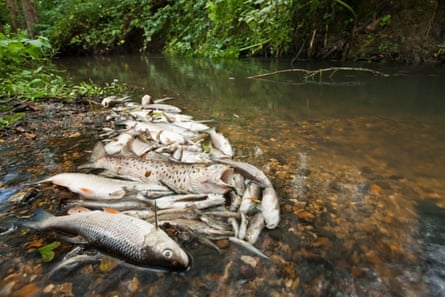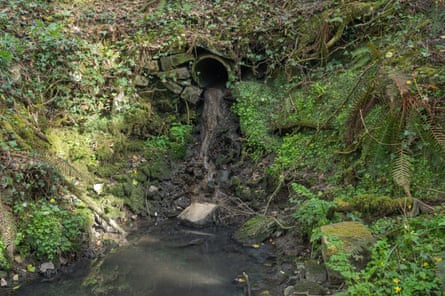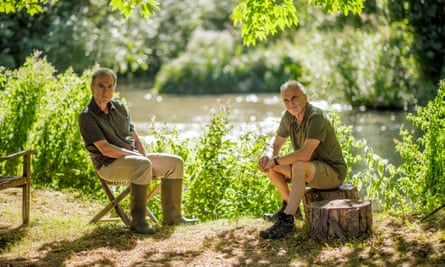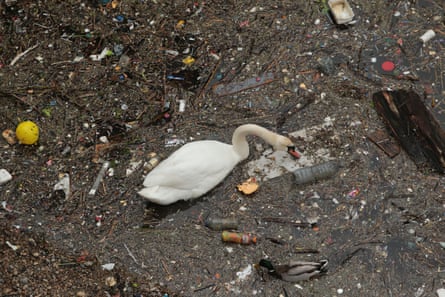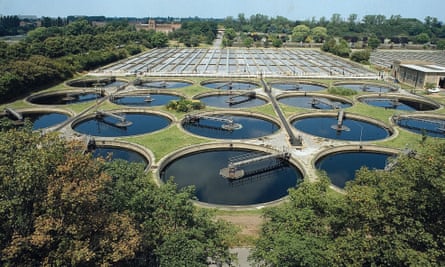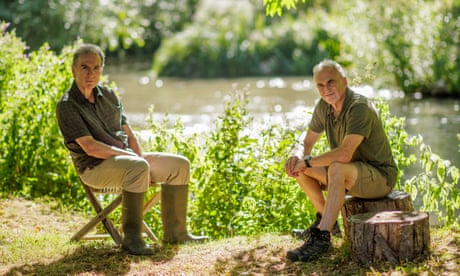Sewage sleuths: the men who revealed the slow, dirty death of Welsh and English rivers
But in the past couple of decades, that progress has flatlined. It is not just Hammond and Smith who are alarmed about their local river: so are anglers, swimmers, canoeists and naturalists all over the country. And it is not just urban rivers that are in trouble. Even rural rivers that stayed pristine throughout the years of heavy industry are suffering now.
I live near the River Wye, which rises in Wales before crossing into England. As a boy in the 1980s, I swam past vast swarms of mayfly and huge leaping salmon. I have seen nothing like that for years. Farther south in Wales, the River Usk is, according to a recent report, “degraded and deteriorating”, with trout stocks at their lowest on record. And if the situation is bad in Wales, where less than half of rivers are classed as having “good status” by the government’s own standards, it is worse in England. Barely a seventh of English rivers achieve that level.
“Some of our best loved and most iconic wildlife face a perilous future. We must act now to ensure that generations to come can marvel in the joys that our freshwater habitats can provide, from the magical sight of otters playing in our streams, the vibrant blue flash of kingfishers in flight, and the epic migration of the Atlantic salmon,” said a joint appeal by all of Britain’s major conservation organisations published last September.
Dead fish in a waterway in Hampshire after sewage was released from a water treatment works. Photograph: Rob Read/AlamyMuch of the damage has already been done. The return of otters to Britain’s rivers has been a conservation highlight of the last few decades, but the latest Welsh survey shows the first decline in their population since the 1970s. The number of salmon caught in rivers by anglers in England and Wales has dropped from about 20,000 a year in the mid-1980s to fewer than 10,000 a year now. Almost 90% of English rivers deemed sites of special scientific interest are not being properly conserved despite their highly protected status. The improvement in water quality we were so proud of as a nation has stopped.
This is baffling. Not only do we have strict laws against pollution, but parliament has just given us a new one, in the shape of the Environment Act 2021. And we have – in England’s Environment Agency and Natural England, in Natural Resources Wales, the Scottish Environment Protection Agency and the Northern Ireland Environment Agency, plus the newly created Office for Environmental Protection – public bodies aplenty with the powers to enforce those laws.
So why is the situation so bad? It was a question that Hammond and Smith kept asking themselves. “Slowly but surely, we widened our interest to other rivers nearby, which were getting to a similar state. Fish were disappearing, the weed was disappearing, the bird life was shrinking,” Hammond said. “And I thought: why can’t the Environment Agency see this?”
H
ammond and Smith look remarkably similar. Both are slim, both have grey hair, both wear rimless glasses, both talk passionately but with a similar feel for irony. When they give webinars about the state of our rivers, they almost operate like two halves of the same person, even using the same chair. Instead of moving the camera, they stand up and change places when it’s time for the other one to speak.Their professional qualifications – the academic and the sleuth – were to prove perfectly complementary when it came to uncovering what has poisoned Britain’s waterways. Smith hunted out information with the same seriousness he once brought to his investigations for the Thames Valley police, while Hammond revealed the truth hidden in the data.
“I was sure there was something wrong, and I started asking questions of the Environment Agency, expecting – very naively back then – a professional response and an honest one,” Smith said. In response to Smith’s letters, the regulators and the water companies insisted that everything was fine, despite the collapse in fish populations he could see with his own eyes.
It was a chance encounter with an old friend – an ecologist who had what he called a “dossier of despair” packed full of correspondence with officials, which had achieved nothing – that convinced Smith to change his approach. So, in January 2017, he launched his own investigative efforts, sending freedom of information requests to reveal how many times untreated sewage had been dumped into the Windrush over the previous three years.
“The answer came back: 240, which we were completely shocked by, though it turned out to be a far rosier picture than reality,” Smith said. Sewage kills rivers by flooding them with nutrients, which leads to an increase in algae, which in turn exhausts the oxygen and blocks out the light, thus suffocating fish, insects and plants. The Windrush is a small river, and this volume of sewage would do terrible damage. Remarkably, this sewage dumping had all been waved through by the Environment Agency.
Raw sewage escaping into a river in Carmarthenshire in Wales. Photograph: Camera Lucida Environment/AlamyHammond and Smith wanted to understand more about what was happening so they, along with their neighbours, set up Windrush Against Sewage Pollution (Wasp) in 2018, and went to work. They sent water companies dozens of environmental information requests (EIRs), which allow members of the public to obtain information from public bodies, and were able to gain an increasingly accurate picture of how exactly the sewage plants had been operating.
Before he retired, Hammond’s academic speciality lay in using computers to help physicians diagnose medical conditions in children. By scanning multiple datasets, his software distinguished the characteristic facial features of people with particular genetic or other developmental conditions. His published papers have titles such as Objectifying Micrognathia Using Three-Dimensional Photogrammetric Analysis. Now, he repurposed his software to search charts of sewage data for flaws, just as it had searched photographs for signs of chromosomal abnormalities. “And it worked,” he said. “It worked really well.”
A
sewage works processes waste in different stages. First, it separates the solids from the liquids, then it uses helpful bacteria to destroy harmful bugs. The solids end up either as fuel or fertiliser, while the treated water flows into a river or stream. However, the situation is not always so smooth: many of our sewage works receive not just liquids from our homes, but also water that has run off roads, roofs and elsewhere. This means that when there is heavy rainfall, the increased volume of water can overwhelm the works’ capacity to treat it.On a normal day, Hammond’s graphs showed two humps of high activity, one in the morning and one in the evening, which is when people are flushing their toilets, having showers, washing up and otherwise sending waste down the pipes to be treated, meaning the sensors reported high volume. But when it rains, that pattern changes, water flows through the works continuously, and the dip between the humps rises. Eventually, the flow is so heavy that it overwhelms the plant’s capacity to cope, and the water company faces a choice: either let the sewage back up and gush out of drains and toilets like particularly foul geysers, or vent it into the river untreated.
This is not illegal: water companies are allowed to vent raw sewage at times of exceptional rainfall, but they have to inform the regulators when they have done so. Because the flow of sewage through the works is monitored every 15 minutes, and Hammond had obtained that dataset, he could see what was happening in great detail. He trained his software to spot the characteristic change to a sewage treatment graph that shows the plant has been venting waste without treating it. Then he cross-referenced his findings against the water companies’ own admissions to see if they had informed regulators about them all.
Hammond (left) and Smith by the Windrush. Photograph: Sam Frost/The GuardianThey had not. “For a start, there were gaps,” Hammond told me. “It’s even a breach of permit to provide data to the agency that has gaps of certain sizes in it, like a two-week gap. But we were finding gaps of three months, nine months, a year.” That was bad enough. “And then I got the data about the spills,” Hammond continued. “And I could see pumps were failing, sewage was going into the river and the agency hadn’t noticed. As I dug into it, there was just more and more horror.” But the problem went beyond water companies failing to report when they had vented sewage during heavy rainfall, and failing to maintain their equipment in order to prevent accidental spills. Looking into the data, Hammond noticed something even more shocking: works were venting untreated sewage despite there being no rain at all. Anglers had been complaining about such “dry spills” for years, but until Hammond came along, no one had been able to prove their existence. “Remember, we had no investigatory powers, just the ability to send these EIRs. But Peter took the haystack and found not just one needle, but thousands of needles,” said Smith. “I was delighted.”
In England and Wales, the water companies were privatised in the late 1980s (in Scotland and Northern Ireland, they remain nationalised). The prices they can charge customers are regulated by Ofwat, and their environmental performance is controlled by the Environment Agency or Natural Resources Wales, although – because water crosses the English-Welsh border without regard for politics – Dŵr Cymru (Welsh Water) is regulated by both. It is a bewildering mishmash of overlapping responsibilities but, when lockdown was imposed in March 2020, Hammond expanded his focus by sending yet more requests for information to everyone involved. He then plotted more charts, which his software scrutinised for abnormalities.
His analysis of the two sewage works on the Windrush became an academic paper with a markedly different slant to his previous ones. He also had a new co-author: Ashley Smith. The paper – titled Detection of untreated sewage discharges to watercourses using machine learning – was published in the well-regarded journal NPJ Clean Water in March 2021. Hammond was able to find almost 1,000 unreported instances in the previous 11 years when raw sewage had been vented, some of them lasting for weeks.
I
t bears repeating: the water companies were polluting Britain’s rivers on an almost unimaginable scale, and yet the regulatory agencies had completely failed to spot it, despite having had access to exactly the same data as Hammond, and despite having conducted the very surveys that showed how much of the country’s water was rated “bad, poor or moderate”. How could such a monumental failure have occurred?Government ministers like to point out that the Environment Agency has 10,500 staff and a generous budget of £1.6bn a year. If the agency isn’t doing the job demanded of it, they say, the fault lies with its managers, not with elected politicians. Superficially, it looks as if they have a point, because the government’s funding for the EA has indeed grown by 20% in the past five years.
However, if you delve beyond the headline figures, you see that the vast majority of the government’s funding is allocated exclusively for flood defences, while the money ringfenced for environmental protection has been cut by 80% since 2010. Over the same period, the annual enforcement budget has fallen from £11.6m to £7m – £100,000 less than the sum earmarked for the EA to manage issues around Brexit in 2019-20.
As the enforcement budget has shrunk, so have prosecutions. Today, if a company violates environmental regulations, it needs not worry much about the consequences. In 2007-8, the number of prosecutions brought by the EA reached a peak of nearly 800; by 2020-21, that number had fallen to just 17. Since 2016, when dealing with water companies, which are large and well-resourced, the EA has taken to relying on “enforcement undertakings” – voluntary agreements to do better, often involving a donation to a local Rivers Trust. These do little to discourage wrongdoing, but they have one advantage for the EA – they are an easy way for a cash-strapped organisation to save money, as they do not require any costly court proceedings.
A swan among rubbish and pollution in the River Thames in east London. Photograph: Nigel Bowles/AlamyThe EA has had to cut its monitoring budget, too. Peter Lloyd, a recently retired EA scientist, told a parliamentary inquiry last year that its pollution monitoring system was “so poor, so inadequate and so misleading” – and, he added, it was getting worse. For much of its information on pollution, the agency relies on members of the public calling its hotline. But managers now respond only to the most serious reports – categories 1 and 2, which involve either major or significant impact on the environment. “If someone says ‘the river is a bit green’, that’s category 3 and no further action is taken,” one recently retired EA inspector said, when I asked him what explained the problems in my local river. “If we used to monitor 80 points on the Wye, it’s probably 20 now.” Summing up the problem, he said: “It’s drip, drip, drip. Death by a thousand Tory cuts. There’s never been just one cut, it’s a slow gradual decline.”
The gradual nature of that decline means there has never been a single disaster that the public or politicians can seize on to grasp the scale of the problem, but the regulators’ failure to adequately respond even to the most serious incidents shows how overstretched they have become. In July 2020, people living along the Llynfi, a tributary of the Wye that drains the western slopes of the Black Mountains, spotted hundreds of dead fish in the water. It was a clear category 1 and they phoned it in. But inspectors from Natural Resources Wales, which has been responsible for enforcing environmental regulations in Wales since 2013 (and which has seen its budget cut in line with funding cuts to the whole Welsh government), were already busy at two other callouts, so no one was available to come and take samples. By the time an inspector arrived the next morning, the pollutant responsible for killing the fish had vanished downstream and Natural Resources Wales closed its investigation without prosecuting anyone.
Last year, a lawyer named Guy Linley-Adams sought to access the EA database that details how its officers have responded to different alerts, which must by law be available to members of the public. After months of obfuscation, he was permitted to visit the EA office in Lichfield, where he was ushered to a 2003-era Compaq PC running Windows XP, a version of the software so old it hasn’t been supported by Microsoft for almost a decade. The computer crashed whenever he tried to open a large document, and Linley-Adams was unable to download or print anything, since it couldn’t communicate with the printer. “What was particularly frustrating is that it had taken months for them to agree what office I could to go to; first it was Shrewsbury, and then Tewkesbury, then eventually I get to Lichfield and it’s a complete waste of time,” he told me. “The level of incompetence now within the agency has hit a critical level. The institution is bust. The best you can say for it is that it is managing the terminal decline of the environment in England.”
I mainly write about corruption and kleptocracy, but what’s extraordinary is how similar the situation around environmental enforcement is to that around financial crime. On paper, the laws are perfectly acceptable and regularly updated. The problem is that they are rarely, if ever, enforced. The result is government by press release; Potemkin enforcement; regulatory theatre; decriminalisation by underresourcing.
But there is a key difference between the battle against financial crime and the struggle against pollution – namely, Hammond and Smith, who bypassed the regulators and essentially created their own investigative agency in miniature.
A
s Hammond continued analysing more data, he became convinced that most of England’s sewage treatment works – of which there are several thousand – were breaking the law. He tried taking these findings to the regulators: to Ofwat and the Environment Agency in 2019 and in 2020. In February 2021, he even gave a zoom tutorial to EA staff explaining how his techniques had exposed all these unreported spills.“I was showing them the simple methods I use, and I just put a little bit of algebra on a screen, and they said: ‘Oh, we’re not qualified to look at that kind of thing.’ And I just thought, surely there must be somebody there that can do this,” said Hammond. “And that’s how it went on. We just kept exposing stuff to Ofwat. And they didn’t seem to do anything but, say, bring in some Environment Agency people who we’d already spoken to and been completely unimpressed by.”
Then, at the end of 2020, parliament’s Environment Audit Committee announced an inquiry into the state of rivers in England and Wales, and the Wasp team spotted an opportunity. Committee chair Philip Dunne, whose constituency sits on a tributary of the Severn in southern Shropshire, had already been talking to Smith and Hammond for a private member’s bill intended to improve river quality, and was very receptive to hearing from them. When I spoke to Dunne, he described Wasp as “a formidable campaigning organisation, because they had data to back up the anecdotes”.
Hammond drew up a detailed account of his findings, and submitted it to the committee, whose members were appalled. The MPs invited him to answer their questions in April 2021, then came to see the Windrush for themselves in July. In November that year, Hammond published a new paper that showed how the Mogden sewage works, which is the third-largest in the UK and adjacent to Twickenham Stadium, had been sending vast quantities of waste into the Thames. “On each of two days in October last year they spilled 1bn litres-plus, which is the equivalent of 400 Olympic-sized pools of sewage each day. That is 16 Olympic swimming pools an hour for two days,” he told MPs.
Mogden sewage treatment works in west London. Photograph: Thames WaterBillions of litres of raw sewage going straight into the Thames, next to the home of English rugby – that’s the kind of claim that doesn’t go unnoticed for long. The Environment Agency might have been able to overlook an academic publication such as NPJ Clean Water, but could hardly stand by when those allegations were repeated in national newspapers. On 18 November 2021, Ofwat and the EA finally announced an investigation into the water companies in England and Wales.
The next month, all of the water companies bar one (the small Welsh provider Hafren Dyfrdwy) admitted their treatment works might have been non-compliant. The EA said its investigation into the information provided by those companies would require examining billions of data points and could take two years, but preliminary checks suggested “widespread and serious non-compliance”.
It seemed obvious from the timing that Hammond’s revelations had sparked the investigations, but officials were curiously bashful about it, repeatedly referencing “new information” and “these reports”, without saying what the information was or where the reports came from. When pressed, EA chief executive Sir James Bevan recognised that Hammond’s work had fed into the EA’s case and, in one odd exchange with MPs in June last year, even said the EA was “working with” him, which came as quite a surprise to the Wasp team.
“It’s like one of those corruption movies – you take the case to the boss, then realise the boss is the person in charge of it,” said Smith, as we ate chocolate digestives in Hammond’s living room. “They are terrified of crediting us because it exposes them as being utter failures. In their great rewriting of history they keep saying water companies came to them. But that’s utter bollocks. The reason they’re investigating the spillage is because Peter Hammond’s already done it.”
And few industry observers have any doubt of how central Hammond’s work has been. When the Ends Report, a magazine that specialises in environmental policy, published this year’s Power List of the 100 most influential people in the sector, it included Hammond. It wrote: “Arguably he has done more in just over a year than the Environment Agency – and many established NGOs – have in the past decade to convince government of the urgent need to reduce pollution in English rivers.”
S
ince then, even more investigations have begun. Not only are the regulators investigating the water companies, but the new Office of Environmental Protection – which regulates the regulators – is now probing the Department for Environment, Food and Rural Affairs (Defra), Ofwat and the Environment Agency, too, which perhaps helps to explain why the EA’s rhetoric has recently become so combative. “Over the years the public have seen water company executives and investors rewarded handsomely while the environment pays the price,” wrote the chair of the EA, Emma Howard Boyd, in her foreword to the agency’s July 2022 review of the industry’s performance. “The water companies are behaving like this for a simple reason: because they can. We intend to make it too painful for them to continue as they are.” Boyd called for “prison sentences for chief executives and board members whose companies are responsible for the most serious incidents.”Whether or not company directors do face prosecution – and, frankly, I’ll believe it when I see it – Smith and Hammond’s revelations have launched a shake-up of the water industry that will hopefully bring life back to the River Windrush. Before too long, perhaps Hammond’s motion-activated cameras will once more pick up otters playing in his garden, and Smith will see chub and barbel spawning on the golden gravel.
But sadly that won’t do much good for my local river, the Wye – and scores of other rivers around England and Wales – where most of the pollution comes from agriculture, rather than from sewage works, and where there is no quick fix for the problem. Regulators have retreated from checking whether farmers are following the rules around pollution, just as they did for water companies, with identical consequences. And, because the pollutants can flow from fields and farmyards the length of the river, rather than from a limited number of pipes, there is no trove of data that can reveal who in particular is responsible for it.
Or perhaps everyone is responsible. When EA inspectors checked farms along the River Axe in south-west England between 2016 and 2019, they found that almost every farm was non-compliant with the rules for storing slurry, silage or fuel oil, all of which are harmful if they leach into rivers. On almost half of the farms, the inspectors saw pollutants entering the waterway. Farmers told the inspectors they had been flouting the rules because they saw the risk of enforcement as being so low – a problem the regulators know all too well. “Last year, we had sufficient resources that would allow us, in theory, to visit every farm … less than once every 200 years,” Bevan, the EA chief executive, told a parliamentary committee last year. “That is not a great disincentive to a farmer to stay on the right side of the line.”
“I get bloody irritated, and so do most people in the EA,” one veteran EA inspector told me. “The problem is that we don’t have the resources or the legislative muscle to do what everyone knows we need to do. But you only have to look at some of the farms in Herefordshire – they are big businesses, they are not scared of loose legislation or penalty notices. They can ignore all that.”
A year ago, the government provided funding for 50 additional inspectors to check farms in England, which will increase the headcount to 80, but that will only repair some of the damage caused by a decade of underfunding. “Given the length of the river system in this country, having only a few hundred people to oversee them is a pretty tall ask,” said Bevan, in evidence to parliament.
Such interventions from Bevan are noteworthy for their laconic understatement, but the ex-inspectors and current insiders who were prepared to talk to me spoke more in the language of crisis. Although little is being done to prevent sewage and manure from poisoning our rivers, at least we recognise the problem and are seeking to understand it. With regard to other threats, such as those from antibiotic-resistant micro-organisms, microplastics or “forever chemicals” such as polyfluoroalkyl substances – which are used in dozens of consumer products and have been linked to multiple serious diseases – the collapse in funding has reduced research, meaning we are always looking at pollution in the rear view mirror. “We don’t know what’s getting into the rivers. Nobody’s looking,” said another former EA inspector who took early retirement thanks to the funding cuts. “That’s a complete failure.”
So, what’s the answer? Some local groups – such as the Friends of the Upper Wye and the Wye Salmon Association, near where I live – have started testing the rivers for themselves, trying to discover the extent and the origin of the pollution. But gathering the volume of data that Hammond had access to requires resources far beyond even the largest NGOs. Truly understanding what is happening to our waterways could only come from the regulators doing the kind of monitoring and analysis they used to do before their budgets were gutted.
Meanwhile, Hammond and Smith continue to work away at the problem. Hammond is still searching for flaws in what information is available. “It’s never-ending,” he said. “The data is sometimes unreliable, or actually false. And I’m just kind of cataloguing those.” And Smith is analysing the financial returns of the water companies in an attempt to find out what they’ve done with all the money they didn’t invest in improving our infrastructure. Alongside the legal organisation Wild Justice, the Wasp team is seeking a judicial review of the whole water industry, whose profits, they claim, have been made through cheating on an industrial scale.
“What Peter does is actually show the consequences of that,” Smith said. “You’ve got a circle of co-opted regulators, and a deeply embarrassed government that ought to not have had this pointed out by a bunch of volunteer amateurs. Even if you made the government’s response 10 times better than it is now, it would still be rubbish, and it will still be eroded. It needs a complete overhaul to take away criminality being rewarded. Because that’s the model.”
Follow the Long Read on Twitter at @gdnlongread, listen to our podcasts here and sign up to the long read weekly email here.
A tide of effluent, broken laws and ruthless cuts is devastating the nation’s waterways. An academic and a detective have dredged up the truth of how it was allowed to happen – but will anything be done?
P
eter Hammond’s house is so picture-perfect – honey-gold stone, scarlet postbox by the door, pink roses climbing towards the first-floor windows – that it could host a murder in a detective drama. It is a converted mill, and the garden is long, narrow and exuberant, with water on both sides. To the south is the millrace that once drove the stones that ground the corn; to the north is the River Windrush, which runs through Gloucestershire and Oxfordshire on its way to join the Thames.Hammond, a retired professor specialising in machine learning, arrived here two decades ago, and delighted in the variety of wildlife he could see in his garden: voles, otters, deer, foxes, badgers, grass snakes, lizards, swans and ducks, as well as chub, barbel and grayling swimming among the long fronds of the water-crowfoot as it swayed over the gravel beds. Kingfishers perched in the willows. It was only in 2013, when he gained a new neighbour – a keen angler and retired detective superintendent called Ashley Smith – that he realised something was wrong with his Cotswolds paradise.
“It took a fisherman’s eye to see it was so bad,” said Hammond, who has steel-grey hair and a determined jaw, as we walked through his garden recently. Every year the river had got worse, but so gradually that he hadn’t noticed it. “It’s like how you don’t notice yourself getting older, then a friend sees you and says: ‘My God, you’ve got old.’
Smith remembers the two of them leaning on the bridge rail and looking for fish swimming up to spawn in the gravel. That first year, he saw five barbel and two chub. By 2014, the chub had gone, and he saw just three barbel. And that was that. “I haven’t seen a fish since,” he told me.
By now, anyone leaning on that rail wouldn’t see a fish even if it existed: the River Windrush is opaque, its once-clear water running khaki-grey. Where the gravel beds were golden, they are now mired in scum. It’s not just the fish that have vanished, so have the crowfoot plants. “We used to get swans breeding on the little island near our bridge, but they’re gone,” said Hammond. “There’s nothing for them to eat any more.”
Until recently, the story we told ourselves about Britain’s rivers was one of recovery and rebirth. During the Industrial Revolution, the country used rivers as a waste-disposal mechanism, and they died by the score. But, after the second world war, industries were obliged to be more careful, and water companies were forced to clean up sewage. Gradually, life returned. Thanks to decades of careful and laborious work, salmon returned to the Thames and trout to the Taff.
